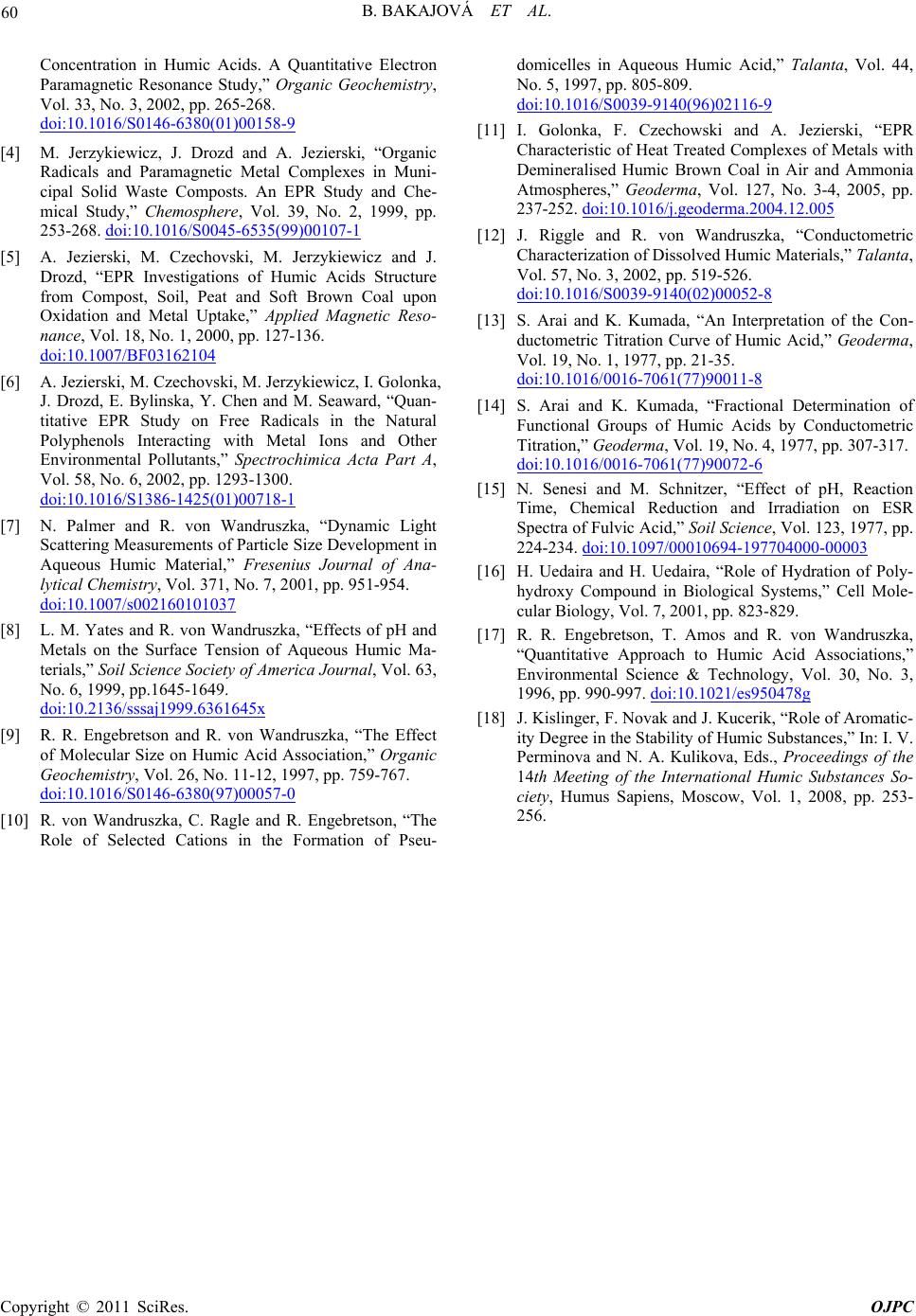
B. BAKAJOVÁ ET AL.
60
Concentration in Humic Acids. A Quantitative Electron
Paramagnetic Resonance Study,” Organic Geochemistry,
Vol. 33, No. 3, 2002, pp. 265-268.
doi:10.1016/S0146-6380(01)00158-9
[4] M. Jerzykiewicz, J. Drozd and A. Jezierski, “Organic
Radicals and Paramagnetic Metal Complexes in Muni-
cipal Solid Waste Composts. An EPR Study and Che-
mical Study,” Chemosphere, Vol. 39, No. 2, 1999, pp.
253-268. doi:10.1016/S0045-6535(99)00107-1
[5] A. Jezierski, M. Czechovski, M. Jerzykiewicz and J.
Drozd, “EPR Investigations of Humic Acids Structure
from Compost, Soil, Peat and Soft Brown Coal upon
Oxidation and Metal Uptake,” Applied Magnetic Reso-
nance, Vol. 18, No. 1, 2000, pp. 127-136.
doi:10.1007/BF03162104
[6] A. Jezierski, M. Czechovski, M. Jerzykiewicz, I. Golonka,
J. Drozd, E. Bylinska, Y. Chen and M. Seaward, “Quan-
titative EPR Study on Free Radicals in the Natural
Polyphenols Interacting with Metal Ions and Other
Environmental Pollutants,” Spectrochimica Acta Part A,
Vol. 58, No. 6, 2002, pp. 1293-1300.
doi:10.1016/S1386-1425(01)00718-1
[7] N. Palmer and R. von Wandruszka, “Dynamic Light
Scattering Measurements of Particle Size Development in
Aqueous Humic Material,” Fresenius Journal of Ana-
lytical Chemistry, Vol. 371, No. 7, 2001, pp. 951-954.
doi:10.1007/s002160101037
[8] L. M. Yates and R. von Wandruszka, “Effects of pH and
Metals on the Surface Tension of Aqueous Humic Ma-
terials,” Soil Science Society of America Journal, Vol. 63,
No. 6, 1999, pp.1645-1649.
doi:10.2136/sssaj1999.6361645x
[9] R. R. Engebretson and R. von Wandruszka, “The Effect
of Molecular Size on Humic Acid Association,” Organic
Geochemistry, Vol. 26, No. 11-12, 1997, pp. 759-767.
doi:10.1016/S0146-6380(97)00057-0
[10] R. von Wandruszka, C. Ragle and R. Engebretson, “The
Role of Selected Cations in the Formation of Pseu-
domicelles in Aqueous Humic Acid,” Talanta, Vol. 44,
No. 5, 1997, pp. 805-809.
doi:10.1016/S0039-9140(96)02116-9
[11] I. Golonka, F. Czechowski and A. Jezierski, “EPR
Characteristic of Heat Treated Complexes of Metals with
Demineralised Humic Brown Coal in Air and Ammonia
Atmospheres,” Geoderma, Vol. 127, No. 3-4, 2005, pp.
237-252. doi:10.1016/j.geoderma.2004.12.005
[12] J. Riggle and R. von Wandruszka, “Conductometric
Characterization of Dissolved Humic Materials,” Talanta,
Vol. 57, No. 3, 2002, pp. 519-526.
doi:10.1016/S0039-9140(02)00052-8
[13] S. Arai and K. Kumada, “An Interpretation of the Con-
ductometric Titration Curve of Humic Acid,” Geoderma,
Vol. 19, No. 1, 1977, pp. 21-35.
doi:10.1016/0016-7061(77)90011-8
[14] S. Arai and K. Kumada, “Fractional Determination of
Functional Groups of Humic Acids by Conductometric
Titration,” Geoderma, Vol. 19, No. 4, 1977, pp. 307-317.
doi:10.1016/0016-7061(77)90072-6
[15] N. Senesi and M. Schnitzer, “Effect of pH, Reaction
Time, Chemical Reduction and Irradiation on ESR
Spectra of Fulvic Acid,” Soil Science, Vol. 123, 1977, pp.
224-234. doi:10.1097/00010694-197704000-00003
[16] H. Uedaira and H. Uedaira, “Role of Hydration of Poly-
hydroxy Compound in Biological Systems,” Cell Mole-
cular Biology, Vol. 7, 2001, pp. 823-829.
[17] R. R. Engebretson, T. Amos and R. von Wandruszka,
“Quantitative Approach to Humic Acid Associations,”
Environmental Science & Technology, Vol. 30, No. 3,
1996, pp. 990-997. doi:10.1021/es950478g
[18] J. Kislinger, F. Novak and J. Kucerik, “Role of Aromatic-
ity Degree in the Stability of Humic Substances,” In: I. V.
Perminova and N. A. Kulikova, Eds., Proceedings of the
14th Meeting of the International Humic Substances So-
ciety, Humus Sapiens, Moscow, Vol. 1, 2008, pp. 253-
256.
Copyright © 2011 SciRes. OJPC